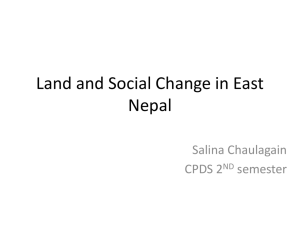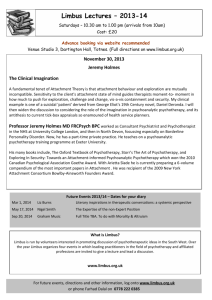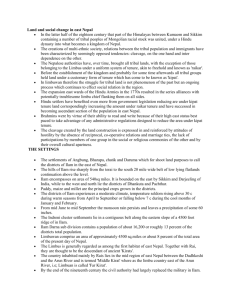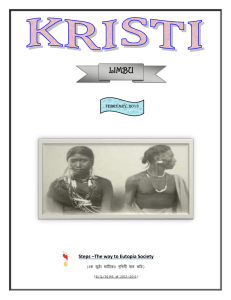Land and social change in the East Nepal: A study of Hindu
advertisement
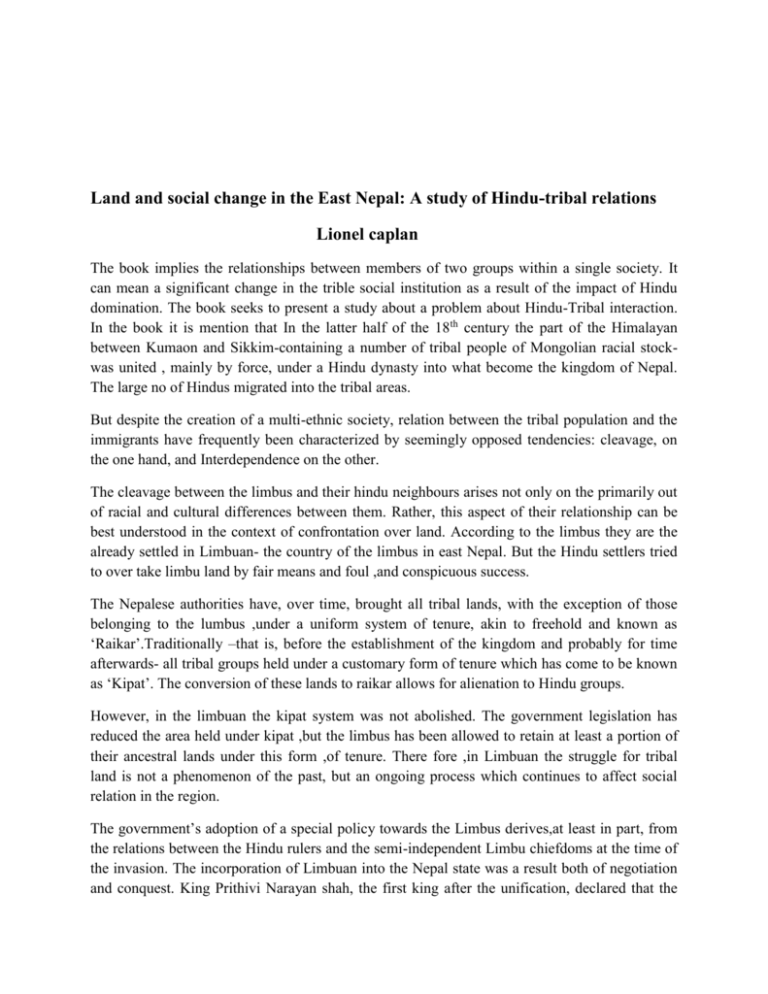
Land and social change in the East Nepal: A study of Hindu-tribal relations Lionel caplan The book implies the relationships between members of two groups within a single society. It can mean a significant change in the trible social institution as a result of the impact of Hindu domination. The book seeks to present a study about a problem about Hindu-Tribal interaction. In the book it is mention that In the latter half of the 18th century the part of the Himalayan between Kumaon and Sikkim-containing a number of tribal people of Mongolian racial stockwas united , mainly by force, under a Hindu dynasty into what become the kingdom of Nepal. The large no of Hindus migrated into the tribal areas. But despite the creation of a multi-ethnic society, relation between the tribal population and the immigrants have frequently been characterized by seemingly opposed tendencies: cleavage, on the one hand, and Interdependence on the other. The cleavage between the limbus and their hindu neighbours arises not only on the primarily out of racial and cultural differences between them. Rather, this aspect of their relationship can be best understood in the context of confrontation over land. According to the limbus they are the already settled in Limbuan- the country of the limbus in east Nepal. But the Hindu settlers tried to over take limbu land by fair means and foul ,and conspicuous success. The Nepalese authorities have, over time, brought all tribal lands, with the exception of those belonging to the lumbus ,under a uniform system of tenure, akin to freehold and known as ‘Raikar’.Traditionally –that is, before the establishment of the kingdom and probably for time afterwards- all tribal groups held under a customary form of tenure which has come to be known as ‘Kipat’. The conversion of these lands to raikar allows for alienation to Hindu groups. However, in the limbuan the kipat system was not abolished. The government legislation has reduced the area held under kipat ,but the limbus has been allowed to retain at least a portion of their ancestral lands under this form ,of tenure. There fore ,in Limbuan the struggle for tribal land is not a phenomenon of the past, but an ongoing process which continues to affect social relation in the region. The government’s adoption of a special policy towards the Limbus derives,at least in part, from the relations between the Hindu rulers and the semi-independent Limbu chiefdoms at the time of the invasion. The incorporation of Limbuan into the Nepal state was a result both of negotiation and conquest. King Prithivi Narayan shah, the first king after the unification, declared that the Limbus,in return for their support,were assured a measure of internal rule under their chiefs and guarantee their rights to their ancestral lands. Due to the land pressure and excessive social evpenditure,among other things ,have forced them to turn for assistance to the wealthier Hindus in their midst. They are dependent on the latter for credit.To obtain the loans the limbus have to pledge their lands. Under the system prevailing in this part of Nepal, the creditor, in lieu of interest, gets the right to cultivate the land as long as the loan is outstanding. The Hindus ,for their part, are anxious to have cultivation rights to these kipat lands, since their own raikar land are in short supply. Limbus has been deprived of the usufruct of their lands. Kipat land is not permanently alienable. This means that however long a Hindu creditor retain the usufruct the land belonging to the limbus debtor,he can’t become the owner of the land. The limbus has oly to repay the loan to repossess the land. Limbus have been able to reposess their land after the significant source of income,i.e. cash income from the service as mercenaries in the Gurkha regiments of foreign armies and varieties of local commercial opportunities since the overthrown of rana regime. Note: Raikar has been described as a system of state Landlordism under which the right of an individual to utilization and the transfer of the land are recognized by the state so long as taxes arre paid. Illam district The settlement of Angbung, Bharapa, Chitok and Dorumba, known as Indreni Cluster in the book, are situated in the istrict of Illam in east Nepal. Illam encompasses an area of 540 sq.miles .It is bounded on the east by Silkkam and the Darjeeling district of West Bengal,While to the west and north lie the districts of Dhankuta and Panchthar. The area is mainly characterized by irregular terrain and poor soil. Paddy,maize and millet are the principal crops grown in the district. The district of Illam experiences a moderate climate, temperature seldom rising above 30°C during the warm season or falling below 7°C during the cool months. Illam contains a small basin,drained by four riversMai, Pua Mai, Deo Mai and Jog Mai. The Indreni settlements lie in a contiguous belt along the eastern slope of 4500 ft ridge in the Illam- Darda sub division of the district. Illam –Darda with an area of 55 sq. miles,compromises about 10% of the total area of the district. iT contains the population of about 16,200 or 13% of the district total.This makes the Illam Darda the most densely settled of Illam’s four sub divisions. Illam is one of six districts in east Nepal which constitute what is what is known as LIMBUANthe country of the Limbus.Lying east of the Arun River, between the high Himalayan and the plains, Limbuan comprises an area of appro. 4500 sq. miles,or 8% of the total area of the present day Nepal. The Limbus and the Rais ,ar thought to be the descendants of the ancient kirats. Among two, the Limbus are generally regarded as the frst inhabitants of east Nepal. The country inhabitants by Rais lies in the mid-region of east Nepal etween the Dudh Kosi and the Arun rivers and is termed as “Middle Kirat” Whereas the Limbu country east of the Arun river,i.e.,Limbuan ,is called “Far Kirat”. The Indreni Cluster The Indreni cluster of settlements is contained in the village of Syawa.The heterogeneous population of the village is probably not untypical of Illam’s. In contains 13 different groups(table 1). The indreni settlements are located between three and four miles north of Illam bazaar,the district capital. They straddle a road which leads from the capital to a point about eight miles away, where the district’s only lake is situated. TABLE.1 Syawa village population Hindus Brahmans Jaisis Chetris Limbus Other tribal groups Rais Sunuwars Gurungs Magars Tamangs Newars Unouchables Blacksmith Tailors Cobblers CLAN AND LOCAL CLAN SEGMENT The limbus are divided into a number of named units which may be referred to as subtribes,although they normally allude to these units as thar,which is the same word they use for the clan. The local clan segment are Chongbung, Kambo, Nembeke, Syeling, Phatra.By virtue of membership of such local clan segment a Limbu obtain rights to ownership to Kipat land in the territory with which it is associate. According to the author, Kambos are in fact the descendants of the fifth Chongbung sibling who came to the Indreni settlements with the eldest brother. Another relates that Chongbungs and Kambos were one clan until a severe famine occurred.Some members of the clan ate a species of stinging nettle found in the hills, and these people came to be known as Chongbungs. Others ate soil, and they became Kambos. Lineage When segmentation occurs within the local clan segment the unilineal descent groups which emerge can be called lineages. The lineages is the core of and to a large extent synonymous with the tax-paying unit. Kipat taxes are leveled without reference to the amount of land owned and cultivated. A Limbu pays tax as a member of a Kipat owning group provided he builds a homestead and establishes a right to a plot of the group’s land taxes are paid to government – approved tax-collector or headmen. Lineage is vary in size and extent of Kipat ownership. Chongbung lineages average 51.2 persons, Kambo lineages 18.5 and the Nembeke group totals 48 persons. HOUSEHOLD An individual obtains rights to kipat land by virtue of membership in a patrilineal descent group. These rights, however, devolve through the mediation of the household with which it is affiliated. By a household, an author mean a group of relatives sharing a common kitchen and budget. The majority of the Limbu Household can be classified as a simple type. Such households may consist only a core and include no other members. Over half of all Limbu household are of this kind. Others may include widowed mothers or unmarried brothers of household heads. Six kinds of simple type household are found in the Indreni settlements. Besides simple type household, there is existence of the Joint-type household .Joint type household are those which include a married couple or widower and at least on of their married sons and spouse. There is some reason to suppose that the incidence of joint type house-holds was higher in former times. Informants insist that in only rare instances would a son have separated from the main household before his father’s death. The partition of households probably did occur at a later stage of the developmental cycle, since young men who were married at the age off puberty could not hope to establish new house-holds until they and their wives were sufficiently mature. But whatever the truth of the contentions about the past the case today is that Limbu households seldom remain at the joint stage for more than a few years. Separation from the main household is generally in sequence, with the eldest son leaving first, followed by his younger brothers as they marry and bring their wives to join them. It is not unusual, however ,for youngest sons, after marriage, to remain with their parents or widowed mother once their elder brothers have separated. The household partitions are most frequently attributed to disputing daughter-in–law. When the married sister returned to the natal homes, leaving permanently her husband house then the tension arises between her and in law causes the breakdown of the household. Besides this, the daughters are allowed the customary privilege of earning a private income which no other members of the household can exercise claims. Although in-married wives also have certain rights to possess property outside the household estate but it is not until they are mistresses of their own households that they can fully exploit their rights. The final property of the parents called Jiuni, which a father puts aside for himself and his wife to sustain them in old age, is hand over to the inherit decided by the parents. It is usually divided among the sons equally but if the youngest son of the family lives with the parents and support the parents in their old age, he may get the whole property after the death of the parents. The woman has also right in land of the property of parents if she hasnot any brothers. On marriage, a woman forfeits all rights to the lands of her natal household. Unmarried daughters, however , on reaching the age of thirty –five have a claim to a share in the estate equal to one – half the inheritance of each male sibling. In the event of thee woman being an only child, she assumes right to the entire estate following the death of her parents.
